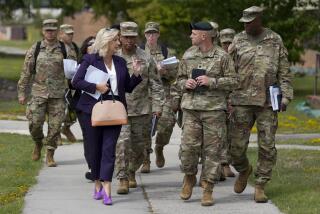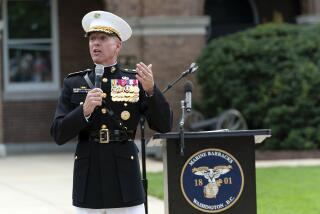Marine Chief Dismisses Cutbacks, Envisions ‘Golden Age’ for Corps
- Share via
Despite a shrinking defense budget that portends significant reductions in personnel and material, Marine Corps Commandant Carl E. Mundy Jr. said Friday that the corps’ future is the brightest he has ever seen.
Speaking at a Navy League luncheon at the U.S. Grant Hotel, the 34-year Marine veteran dismissed the “pessimism” that many career officers are expressing over the paring back of the military and said “this is the golden age” for Marines and the Navy forces that support them.
Mundy based his optimism on the easing of Cold War tensions, which in turn has forced U.S. military planners to focus more on regional conflicts--like the Iraqi invasion of Kuwait--and providing U.S. military expertise to allies beset with internal threats.
He pointed out that most of these international conflicts require a rapid response by U.S. light infantry forces, which act as a temporary deterrent until Air Force and heavier Army units arrive to overcome the threat.
Although the Army has airborne and airmobile troops that can fill this role, the 26,000 Marines deployed on Navy amphibious assault ships and posts throughout the world also constitute a rapid deployment force that can be sent to a trouble spot at a moment’s notice.
“The naval force is the expeditionary force of this country,” Mundy said, referring to the Marines and Navy units that support them. “ . . . We’re the best capability the nation has.”
Mundy’s vision of the future sees lightly armed Marines and their Navy support units as “facilitators” for the introduction of heavier Army units who deliver “the Sunday punch” to the enemy.
This is the strategy that U.S. military planners used during the Persian Gulf War, when light infantry Marine and Army units were sent to Saudi Arabia to help the Saudis defend their country until heavier Army mechanized and armored units arrived weeks later to begin offensive operations.
The performance of U.S. troops in the Persian Gulf War and their technologically superior equipment showed that “there isn’t anybody in the world who can lick us,” Mundy said. And anybody who tries “is going to get waxed,” he added.
Nevertheless, the realities of the new world order will relegate much of the U.S. military to “peacetime engagements,” Mundy added. This means responding to threats against U.S. interests or smaller U.S. allies.
Most of these measured responses will be assigned to light Marine amphibious units, Mundy said.
“Clearly, we don’t any longer need large standing armed forces,” he said.
Amphibious warfare has been the Marines’ hallmark since the 1920s. But, since the end of World War II, critics have argued that amphibious tactics are obsolete on the modern battlefield, especially today when helicopter assaults afford a quicker, deadlier strike at the enemy.
But Mundy pointed out that, during the Persian Gulf War, a Marine amphibious force stationed off the Kuwaiti coast was able to pin down a larger Iraqi force merely by threatening to invade Kuwait’s beaches. The Marines never left their ships.
“You would not want to be without that capability. . . . You want to keep that type of capability around,” Mundy said.
Mundy was appointed commandant by President Bush on July 1. He is presiding over a service that is already being scaled back and is scheduled for a 20% reduction in personnel by 1997.
The Pentagon cutbacks have already begun to affect the Marines. Last week, Marine officials announced that a lack of funding forced them to cancel development of the LAV-105, a light armored vehicle with a 105-millimeter howitzer.
The LAV-105 was designed to add heavy firepower to the Marine light armored infantry battalions. These armored units provide crucial battlefield support for Marine infantry units, the same units Mundy said will play an important role in future regional conflicts.
More to Read
Sign up for Essential California
The most important California stories and recommendations in your inbox every morning.
You may occasionally receive promotional content from the Los Angeles Times.










